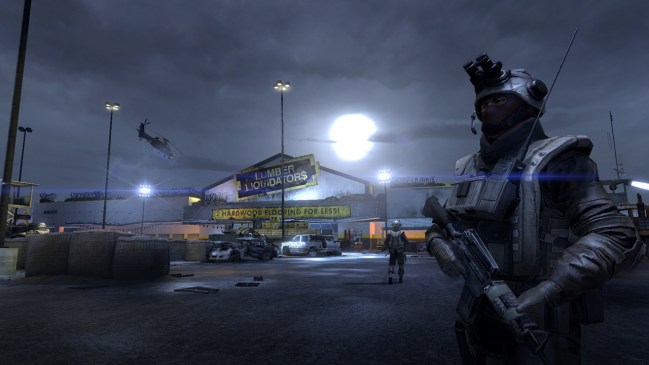
The year is 2027, and following the economic downfall of America, the country has been left open to attack by the now nuclear-backed North Korean forces. The war has already been lost, and the North Koreans have become an occupying force.
Homefront takes place in a speculative future, where Kim Jong-il’s son, Kim Jong-un has taken over North Korea following his father’s death in 2012. Within a year, North Korea has seized control of South Korea, and the Greater Korean Republic (GKR) is born. Meanwhile the economic strain on America continues to grow, and the cost of gasoline has risen to the point that the American military is forced to decrease its sphere of influence.
In 2018, Japan is forced to surrender to the GKR, which increases the power, resources, and size of the GKR’s might. In 2022, the American economy collapses, and the GKR begins to annex several Asian nations.
In 2025, and EMP hidden in a communications satellite detonates over the United States, and the country is thrown into chaos. Hawaii soon falls, a series of orchestrated cyber attacks cripple the remaining American organized forces, and soon the GKR take San Francisco as a foothold. Within a year the U.S. military is scattered, and by 2027, the invasion has become an occupation.
Such is the premise for THQ’s upcoming first-person shooter, Homefront. Written by acclaimed writer/director John Milius (Red Dawn, Conan the Barbarian), the game follows your character as he makes contact with resistance cells, and attempts to co-ordinate guerilla style counterstrikes.
Adding to the creepy factor of this game is the fact that the North Korean leader in the game is Kim Jong-un. Until very recently, the choice of successor for Kim Jong-il remained a complete mystery. Most assumed that Kim Jong-un was too young for the responsibility, but North Korea has recently announced that the third son of Kim Jong-il would be the sole heir. The choice was such a mystery, that until very recently know one even knew what Kim Jong-un looked like, and an actor was used in the original trailers. The clip below was taken from a recent celebration, and does feature the real Kim Jong-un. A coincidence, surely, but one that makes the idea of North Korea occupying America a little less out of the realm of possibility…
But, ridiculous or not, the setting of an occupied America does lead to some interesting graphics and gameplay options. Check out the trailer below, and look for Homefront on PC, PS3 and Xbox 360 on March 8, 2011 in the U.S., March 10 in Australia, March 11 in Europe, and April 29 in Japan.
Editors' Recommendations
- Marathon: release date speculation, trailers, gameplay, and more
- How to earn new cards in Back 4 Blood


